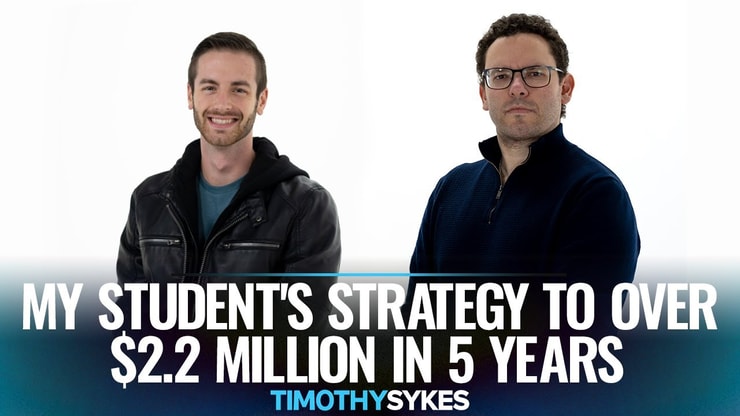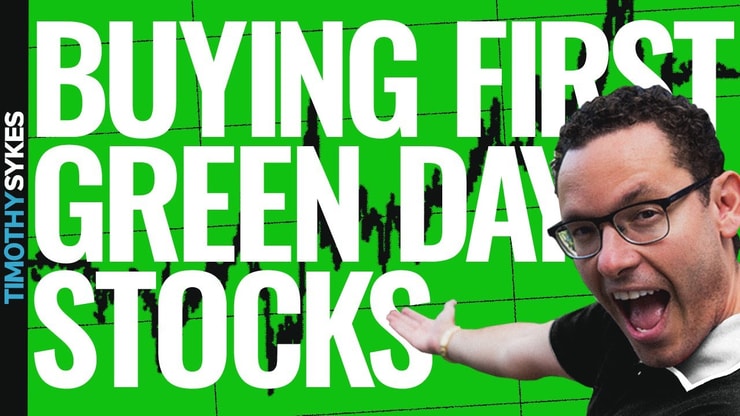How well defined are your trading styles?
Don’t overlook this. It’s completely dependent on your personality, commitment, and emotional make-up.
One of the first steps of your trading journey is understanding different trading styles and finding yours.
Don’t have a style? You’ll likely end up buying and selling random stocks at random times with no plan. That’s a fast track to blowing up your account.
Be smarter than that. Invest in your education. Create a plan for every trade and stick to it no matter what. And commit to adapting to any kind of market. That’s how my top students and I became self-sufficient traders.*
Yes, you have to study harder than ever. But that’s how you find and master YOUR trading style. Read on to learn how to find and hone your style…
Table of Contents
What Are Trading Styles?

A trading style is how you go about trading.
Everyone has a unique trading style. But there are factors that help group traders into categories.
The main factor is how long a trader typically holds positions. If they consistently buy and sell stocks intraday, multiple times a day, that’s a day trader. That’s very different from a trader who only buys and sells stocks a few times a month or year.
Risk tolerance is another big factor. Certain trading styles, like day trading, tend to have more volatility and risk than others. But that volatility and risk can mean the potential for greater gains.
Those are the main factors that help classify trading styles. Now let’s get into specific styles…
The 5 Different Types of Trading Styles
As we go through each style, keep in mind that traders can mix and match or combine trading styles.
There’s no right or wrong. It’s what works for you.
Also, you might avoid a trading style completely because it doesn’t suit you. That’s OK. Just remember it’s smart to learn as much as you can about the stock market. So you may not use all the styles, but understanding how other traders think is never a bad thing.
Always work on building your knowledge foundation. That’s how you can better prepare for whatever the stock market brings. Let’s get to it…
#1. Day Trading
Day trading is buying and selling securities within the same trading day.
Day traders usually place somewhere between one and 10 trades per day. But that also depends on the current market volatility and how many stocks are running.
If it’s a slower day in the markets, sometimes the best trade is no trade. Cash is still a position.
I say that because day trading is one of the riskiest trading styles around. To me, day trading isn’t risky, but that’s because I trade conservatively. If you study hard and learn proper risk management, I think it’s one of the best trading styles to grow an account.
But day trading isn’t right for everyone. Only start day trading if you know you’ll work harder than you ever have. That’s why I only accept the most dedicated students into my Trading Challenge.
The Trading Challenge gives you access to thousands of video lessons, live webinars, an amazing trading chat room, and the ability to learn from some of my previous top students who were once in your shoes. Apply to the Challenge now to find out if you make the cut.
#2. Swing Trading
Swing trading has similar techniques to day trading but on a longer time scale. Swing trades usually last for a few days or weeks.
Swing traders typically open positions based on technical and fundamental indicators that indicate increased volatility. When a stock’s volatile, it can lead to quick changes in price action. That can be good or bad, depending on which side of the move you’re on.
Volatility is intimidating to a lot of traders. If you’re caught on the wrong side of it, your hard-earned cash is toast.
That’s why it’s important you follow rule #1 and cut losses quickly whenever a trade goes against you. There’s no time to argue with the market if you’re in a losing trade. The market always wins. The best thing to do is cut the loss and move on.
More Breaking News
- Navigating the Rising Star: Is Innoviz Technologies the Game-Changer in Autonomous Vehicles?
- The Pharmaceutical Battle: Is Eli Lilly’s Zepbound a Game Changer Against Novo Nordisk’s Wegovy?
- WiMi’s Leap to Innovation: What’s Behind the Latest Surge?
#3. Position Trading
Position trading is different from day trading and swing trading. Some people consider it to be more of a buy-and-hold strategy rather than a trading style.
However, when done properly, position trading can be a trading style that involves lower risk and longer holding periods.
Position traders use longer-term charts to follow trends and decide which stocks to buy. They usually buy (or short sell) stocks after spotting an established trend and ride the long-term momentum.
In terms of trading styles, I think this one takes a lot of patience. You don’t cut out the second a trade goes red. You wait and see if the trend is completely over before getting out.
This kind of trading isn’t for me. I’ve drilled cutting losses quickly into my brain. But this might be a good strategy for you if you have more of a buy-and-hold type of mindset.
#4. Scalping
This trading style focuses on profiting from frequent, small price fluctuations. With this style, traders hold positions for a few minutes or seconds.
A scalper’s goal is to make lots of small profits that eventually add up to greater profits. They often use lots of leverage to boost profits, since they trade tiny price fluctuations.
My #1 rule, cutting losses quickly, is important for scalpers too. If they don’t cut losses quickly on a losing trade, they might wipe out all their gains from the past 10+ trades. To me, that risk is too high compared to the potential reward. That’s why I stay away from scalping.
#5. Momentum Trading
Momentum trading is all about riding the hype. If everyone’s piling into a stock, you can assume that all the momentum traders are there too.
The idea behind momentum trading is that increased volume will bring increased volatility and push the stock further in the direction it’s already headed.
This trading style has proven itself over the years. More and more traders find themselves trading momentum stocks.
The potential for gains can be great, even for those with small accounts.
I started trading with the roughly $12,500 I received for my bar mitzvah. Now I’m up to over $7.1 million in trading profits all thanks to my two favorite trading styles — day trading and momentum trading.*
But are those the most profitable trading styles? Let’s find out…
What Type of Trading Is Most Profitable?

Newbies always want to know what type of trading is most profitable so they can hop on the bandwagon and “make millions instantly.”
But guess what … That’s not how the stock market works. If you think you can just start a new trading style and become an instant millionaire, think again.
The stock market always wins. If you think you deserve a big win because you’ve been in lots of losing trades, you’re wrong. If you think swing trading, or any other trading style for that matter, is the most profitable, you’re wrong.
There isn’t one type of trading that’s the most profitable.
What I think is more important than the trading styles you follow is how hard you’re working.
Have you done your due diligence in the markets? Have you paid your market tuition? Ask yourself those questions every day. Trading takes a ton of hard work, and even then, there’s no guarantee you’ll find success.
But don’t give up just because you aren’t seeing success right away. Some of my top students took four or five years before they became successful traders.* Keep at it — just check out Kyle Williams’ story…*
How Can You Find Your Trading Style?
Finding your trading style is crucial. If you’re a beginner who still hasn’t found what trading style suits you best, pay close attention here. This can help you understand what to consider when picking your trading style.
Here are some questions to ask yourself…
- Are you patient or impatient? Impatient people might do better in short-term trading methods like day trading.
- How much screen time can you put in? If you work a 9-to-5 job and will miss most of the market hours, it might be smarter to stick to swing trades or position trades that don’t require as much screen time.
- Do you welcome volatility or shy away from it? Position trading can be less volatile than day trading. Again, know the level of volatility that’s comfortable for you.
- Are you comfortable with overnight holds? Big overnight holds can separate day traders from swing traders. Consider how you’d feel holding certain stocks overnight.
After you narrow down to a few trading styles, start testing. Keep a trading journal and take note of what works best for you. Then zero in on mastering that style.
Remember, you don’t have to limit yourself to one trading style. I’ve used multiple trading styles at different points. But I focus most on day trading because that’s what I’m best at.
Bonus Tips: 3 Professional Trading Strategies for Beginners

Once you’ve found your trading style, it’s time to start studying different trading strategies and patterns. The 3 professional trading strategies I’ll cover next are also patterns that repeat often. I think these can be good starting points for beginners.
You’ll notice that I haven’t listed any short-selling strategies. That’s because I think short selling is way too risky for beginners these days. For now, we’ll focus on long strategies…
1. Panic Dip Buy
This is my favorite pattern. I love it because it’s fairly easy to get the hang of and it happens a LOT in the OTC markets. This strategy works a little better for day trading, but it can work for other trading styles too.
The way to spot this pattern is to look for a stock that’s risen a lot over the past several days or weeks. Then, suddenly, there’s a sell-off. Shareholders panic and sell. This creates a quick dip in price action.
I look for at least a 20% drop. But generally, the bigger the drop, the better. After the big drop, buyers see a discounted price and start piling in. That can cause the price to quickly shoot back up.
Level 2 quotes can make it easier to see the shift in price action and help you time your entry.
Check out my “Learn Level 2” DVD to help you prepare for panic dip buys when they come around. And there will be some before you know it. This strategy has been around for so long, I don’t see it going away anytime soon.
2. First Green Day
This pattern starts with a catalyst.
A catalyst is anything that causes a stock’s price to spike and brings in more volume. It can be great earnings, a product launch, a billionaire buying in, or any other positive news. But it doesn’t matter what the news is … What matters is how the market reacts to the news.
With this strategy, you’re looking for stocks that moved big and grinded up all day. The idea is that most people haven’t seen the positive news yet … And when they eventually do, the stock will continue higher because of the buyers’ momentum.
However, if a stock has a full-on supernova right out of the gate then fades all day, that’s not what you’re looking for with this strategy. You want to buy stocks that close near the high of the day. Those can likely gap up the following morning.
3. Breakouts
This strategy works for just about all trading styles. When buying breakouts, you look for a stock that breaks through resistance levels. Then buyers pile in and take control, which then pushes the stock price higher.
Breakouts can happen in more than one way — some occur in one day and some can take years to develop. But the idea remains the same. When a stock breaks out, it can grind higher.
This is another of my favorite strategies. To me, it’s so simple and effective.
And using StocksToTrade can give you the ability to set customizable alerts on stocks that have the potential to break out. That way you won’t miss out when they do. Just another reason I use StocksToTrade every day.**
Trading Styles: The Bottom Line

Trading styles are all about your personality, commitment, and emotional make-up.
If you’re like me, you might like to get a lot of screen time and be in and out of stocks quickly. Or maybe you work long days at a 9-to-5 and don’t have much time to day trade as I do.
Either way, I think you can find a trading style that works for you.
There isn’t one type of trading that’s always more profitable than another. It all depends on how hard you work. But don’t think you deserve money just for placing a certain number of trades.
So whether you’re a day trader, swing trader, position trader, or any other type of trader — work hard and don’t give up.
What do you think? Which trading styles best suit you? Let me know in the comments…
Disclaimers
*This level of successful trading is not typical and does not reflect the experience of the majority of individuals using the services and products offered on this website. From January 1, 2020, to December 31, 2020, typical users of the products and services offered by this website reported earning, on average, an estimated $49.91 in profit.
**Tim Sykes has a minority ownership stake in StocksToTrade.com.







Leave a reply